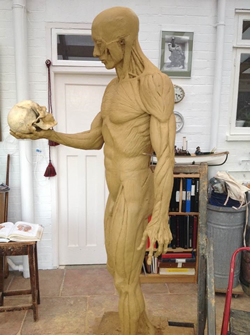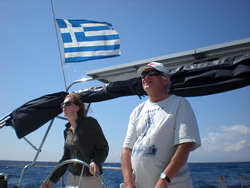This article is part of the series "A Moment in History" where we honor those who have contributed to the growth of medical knowledge in the areas of anatomy, medicine, surgery, and medical research.
If you arrived directly to this article, the first article in this three-page series can be read HERE
Sculpting the monument in Richard Neave’s studio
One of the most important conferences that BIOMAB initiated and co-organized was without doubt “Vesalius Continuum” which took place in 2014 on the island of Zakynthos . This joint AEIMS conference was organized in collaboration with Dr Mark Gardiner and the then Consul at the Belgian Embassy in Greece - Theo Dirix, and brought together many prominent scholars and Vesalius experts who presented papers on the life, work and death of Vesalius, and the influence of the Fabrica on modern anatomy, and on medical art and contemporary art (pdf file).
Without the organizing skills and drive and energy of Dr. Mark Gardiner and the countless meetings and emails with Theo Dirix, the conference Vesalius Continuum would not have been the huge world class event it became.
In 2013 Dr. Mark Gardiner and I first introduced ourselves to Professor Vivian Nutton who was giving a lecture at Warwick University about the incredible find of a hand written (by Vesalius himself !) edited version of the Fabrica’s second edition, which would have become the third edition, …had Vesalius not met his untimely death. Mark and I were blown away by this wonderfully exciting lecture and we asked Professor Nutton to be a speaker at our conference in 2014, which he accepted gladly. He was invited again in 2017 for the triennial and has now especially for this publication written an exciting account of Vesalius in England, 1544 to 1547.
Vesalius’s 500 th anniversary celebrations did not end with the organization of the conference, but became a collection of several events.
My colleague and dear friend forensic medical artist Richard Neave and I sculpted a bronze monument to commemorate Vesalius’s death on the Island of Zakynthos on 15th Oct 1564. This monument might never have been erected if it were not for the wonderful idea of Antwerp GP and president of Vesaliana Dr Marc de Roeck together with William Nagels, who devised a way of self-funding this large undertaking. We had countless meetings discussing the monument and agreed with Dr. de Roeck that by making a bronze facial reconstruction portrait (made by Richard Neave and myself) and selling 12 copies we would gather enough money together to make the monument, pay to have it cast in Bronze and drive the sculpture from Belgium to Zakynthos ready to have its grand inauguration at the start of the conference. This was all achieved successfully and the sculpture now stands on the Island of Zakynthos’s Vesalius square, facing the Ionian sea.
Dr. Marc De Roeck and Pascale Pollier
sailing to Zakynthos
In 2009 I had completed a facial reconstruction course at the academy of fine arts in Maastricht , the Netherlands, and as Vesalius had always been my big inspiration and the reason why I chose to become a medical artist, it was my dream to make a facial reconstruction of Vesalius. The dream soon turned into a passion, and the passion into an obsession to go in search of the grave of Vesalius and find his skull.
Ann suggested to Marc we sailed to Zakynthos with the MYC-Medical Yachting Club to start the quest for the grave. I will never forget the day that Marc gave me the ships wheel as we got closer to the island and I sailed into the harbor of Zakynthos! An amazing feeling!
After our first visit to “what we thought then was the grave site“ at Laganas, I wrote a letter to the Belgian embassy in Greece, asking for help with our quest, a year later when Theo Dirix took office as Consul he wrote back to me, my letter had ignited a flame in the heart of taphophile Theo Dirix.
Soon the quest became an official scientific research collaborative project between the Belgian School of Athens (Jan Driessen, Apostolis Sarris, Sylviane Déderix) and the Greek authorities, together with the invaluable research of Omer Steeno, Maurits Biesbrouk and Theodoor Godeeris, who all share their latest findings in this book. With this wonderful collaborative effort, even though we have not yet found the actual grave, we can truly claim that we have made some history.
Theo Dirix wrote 2 books on the quest of the grave and now will reveal some new insights with his article in the book “In the Shadow of Vesalius”.
This article continues HERE




